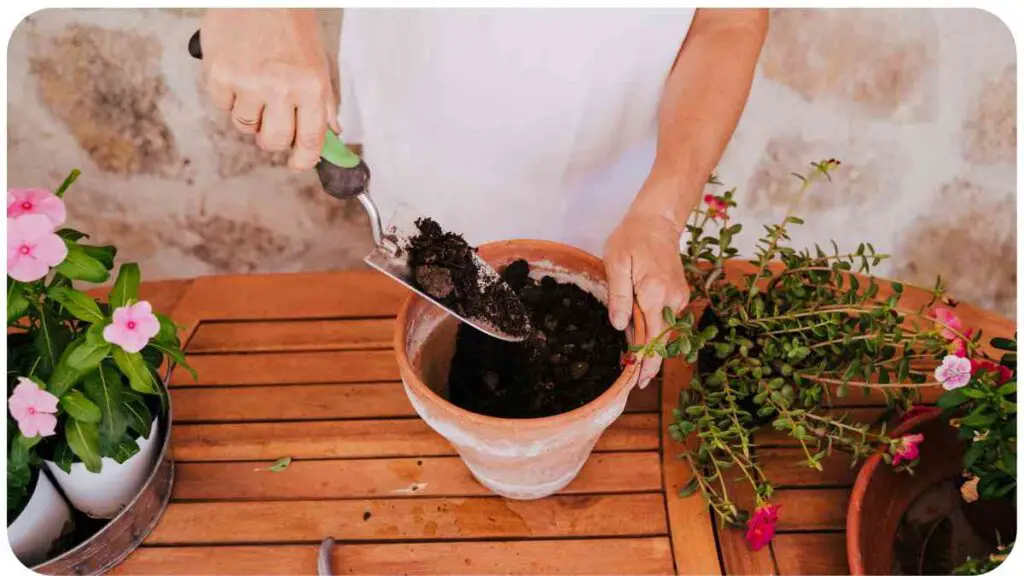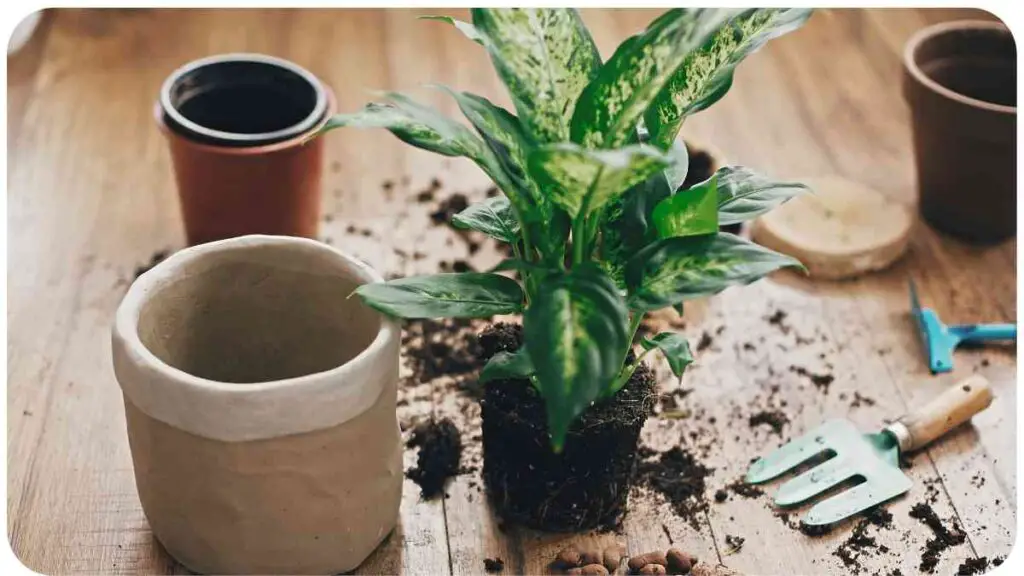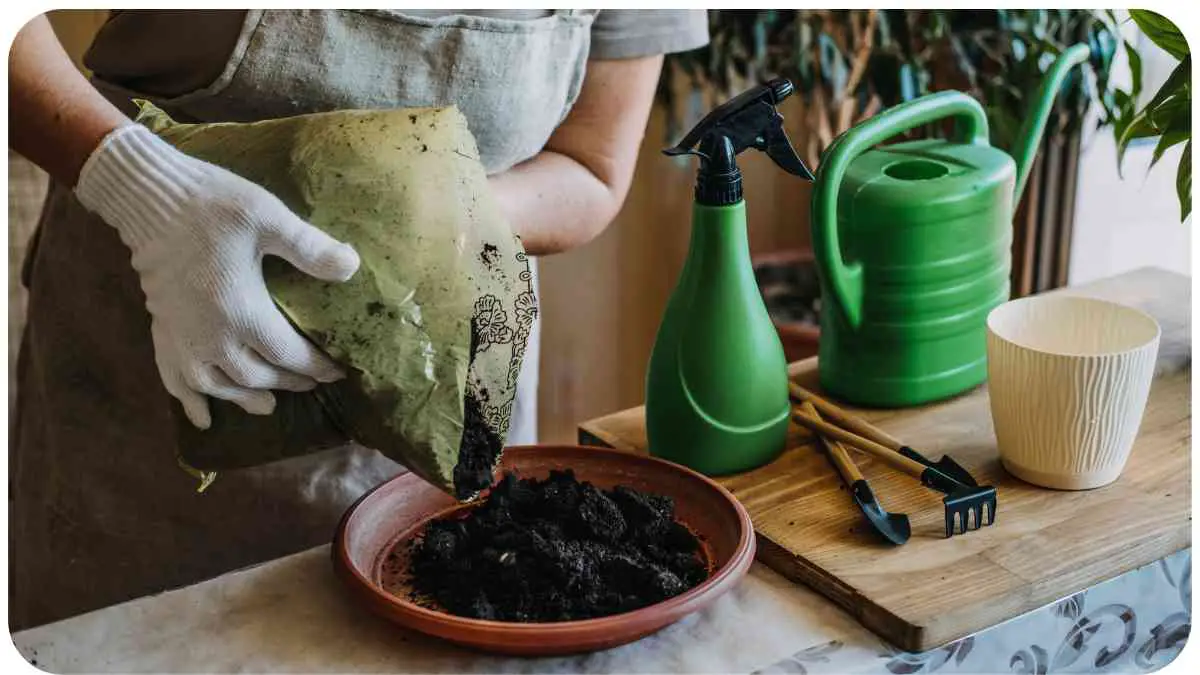When it comes to potting plants, the kind of soil you choose can make a world of difference. The right potting soil not only supports healthy growth but also impacts how often you need to water your plants. So, what kind of soil do you use for potting plants? Let’s dig in!
What Is Potting Soil?
Potting soil, often referred to as potting mix, is a specially formulated substrate used for growing plants in containers. Unlike regular garden soil, potting soil is designed to provide the right balance of nutrients, moisture retention, and aeration to support potted plants. It’s typically lighter and fluffier, which allows roots to breathe better.
| Takeaway |
|---|
| Choosing the right potting soil is crucial for plant health. |
| A good potting mix should retain moisture while providing adequate drainage. |
| Look for mixes that contain peat moss, perlite, and compost for best results. |
| Regularly check soil moisture and adjust your watering routine accordingly. |
| Avoid using regular garden soil, as it can lead to compaction and pests. |
| Fertilizing potting soil can enhance plant growth and nutrient availability. |
| Organic options are available and can be beneficial for both plants and the environment. |
| Always consider the specific needs of your plants when selecting soil. |
| Replacing old potting soil can prevent disease and promote better growth. |
| Pay attention to signs of soil health, such as odor or compaction, to maintain optimal conditions. |
Difference Between Potting Soil and Garden Soil
It’s essential to understand that potting soil is not the same as garden soil. Garden soil can be heavy and compact, making it difficult for roots to grow. Potting soil, on the other hand, is specifically formulated for containers. Here’s a quick comparison:
When planning your garden, choosing the right plants is key. If you’re wondering what plants to grow for privacy and beauty, this guide provides excellent options, from shrubs to vines, that will enhance the look and function of your outdoor space.
| Feature | Potting Soil | Garden Soil |
|---|---|---|
| Texture | Light and fluffy | Dense and compact |
| Drainage | Excellent | Poor |
| Nutrient Content | Balanced | Varies |
| pH Levels | Controlled | Varies |
| Weed Seeds | Minimal | High |
Key Ingredients of Potting Soil

Peat Moss
Peat moss is one of the primary ingredients in most potting mixes. It helps retain moisture while also improving aeration. However, it’s worth noting that peat moss is not a sustainable resource. If you’re environmentally conscious, consider alternatives like coconut coir.
Perlite
Perlite is a volcanic glass that is heated and expanded to create small, lightweight granules. It’s excellent for improving drainage and aeration in potting soil. If your plants like to stay moist, you might want to use a mix that includes perlite.
Vermiculite
Similar to perlite, vermiculite is a mineral that has been heated to create a lightweight material. It has great moisture-retention capabilities and is perfect for seedlings and young plants that require consistent moisture.
Creating a backyard that is both safe and enjoyable for pets requires some research. If you’re considering dog-friendly backyard features to install, this article outlines creative and practical solutions to make your yard a haven for your furry friends.
Compost
Compost is a fantastic organic ingredient that adds nutrients back into the soil. It improves the soil’s texture and provides beneficial microorganisms that help your plants thrive. Look for well-aged compost for the best results.
Types of Potting Soil
Seed Starting Mix
A seed starting mix is lighter and finer than regular potting soil. It’s designed to help seeds germinate quickly without the risk of disease. If you’re planning to start seeds indoors, this is the way to go.
Cactus and Succulent Mix
Cacti and succulents thrive in drier conditions, so their potting mix typically contains more sand and perlite for excellent drainage. This prevents root rot, which is a common issue for these types of plants.
All-Purpose Potting Mix
This is the most versatile option and works well for a wide range of plants. It usually contains a mix of peat, perlite, and compost, providing balanced moisture retention and aeration.
If you’re dealing with a worn-out deck, knowing how to restore it can make all the difference. This comprehensive guide walks you through the process, offering tips to bring life back to your wooden structure, making it look new again.
Organic Potting Soil
If you’re into organic gardening, look for potting soil labeled as organic. These mixes often contain natural materials like compost, worm castings, and organic fertilizers.
Choosing the Right Soil for Your Plants
Consider the Plant Type
Different plants have different soil needs. For instance, tropical plants prefer moisture-retentive soil, while succulents need something that drains quickly. Always consider the specific needs of your plant.
Understand Drainage Needs
Drainage is crucial for plant health. If your potting soil retains too much water, it can lead to root rot. On the flip side, if it drains too quickly, your plants might not get enough moisture. Find a mix that strikes the right balance.
Lighting can transform your backyard into a magical space. If you’re interested in learning how to put up lights efficiently, this article covers everything from string lights to path lighting, helping you create a warm, inviting ambiance for any occasion.
pH Levels and Nutrient Content
Most plants thrive in a slightly acidic to neutral pH level (around 6.0 to 7.0). Check the nutrient content of your potting soil to ensure it meets the needs of your plants. Some might require additional fertilization to thrive.
DIY Potting Soil Recipes

Basic Potting Soil Mix
If you want to create your own potting soil, here’s a simple recipe:
| Ingredient | Ratio |
|---|---|
| Peat Moss | 1 part |
| Perlite | 1 part |
| Compost | 1 part |
Mix these ingredients thoroughly to create a balanced potting soil that works for many plants.
Seed Starting Mix Recipe
For a seed starting mix, you can try this recipe:
| Ingredient | Ratio |
|---|---|
| Peat Moss | 1 part |
| Perlite | 1 part |
| Vermiculite | 1 part |
This mix ensures seeds have the perfect environment for germination.
Cactus and Succulent Soil Recipe
For your cacti and succulents, here’s a great recipe:
| Ingredient | Ratio |
|---|---|
| Coarse Sand | 2 parts |
| Perlite | 1 part |
| Peat Moss | 1 part |
This mix will help your plants drain efficiently and thrive in dry conditions.
Common Mistakes When Potting Plants
Potting plants might seem straightforward, but many people make common mistakes. Overwatering is a frequent issue, leading to root rot. Additionally, using the wrong type of soil can hinder your plant’s growth. Always do your research before potting!
Having a lush lawn is every homeowner’s dream, but it requires some work. To achieve that, you need to know how to take care of your lawn, and this guide offers practical tips for maintaining healthy grass, keeping your backyard in top shape year-round.
FAQs about Potting Soil
What’s the best potting soil for indoor plants?
The best potting soil for indoor plants is usually an all-purpose mix that retains moisture but drains well. Look for a mix that contains peat moss, perlite, and compost.
Can I use garden soil for potting?
It’s not recommended. Garden soil can be too dense and may harbor pests and diseases. Instead, opt for a quality potting mix.
How often should I report my plants?
Report your plants every 1-2 years or when you notice roots growing out of the drainage holes. This helps refresh the soil and provide more space for growth.
What’s the difference between organic and non-organic potting soil?
Organic potting soil contains natural ingredients and no synthetic chemicals. Non-organic mixes may contain chemical fertilizers and additives. Organic is typically better for the environment and your health.
Can I make my own potting soil?
Absolutely! Making your own potting soil allows you to control the ingredients and tailor the mix to your plants’ needs. Use the recipes provided in this article as a starting point.
Conclusion
Choosing the right soil for potting plants is crucial for their health and growth. By understanding the different types of potting soil and their ingredients, you can create a thriving environment for your plants. Whether you go with a store-bought mix or make your own, your plants will thank you for it!
Further Reading
What Is the Best Soil for Container Gardening?
This article offers insights into the best types of soil for container gardening, focusing on moisture retention and nutrient balance to ensure healthy plant growth.
How to Choose Potting Soil
Garden Design provides a comprehensive guide on selecting the right potting soil for your plants, discussing various mixes and their specific uses to help you make informed choices.
What Is the Best Soil for Potted Plants?
This blog post explores the essential qualities of potting soil, emphasizing the importance of drainage, aeration, and nutrient content for optimal plant health.
FAQs
What is the best type of soil for potting plants?
The best type of soil for potting plants is typically a high-quality potting mix that combines peat moss, perlite, and compost, providing good drainage and moisture retention.
How do I know if my potting soil is still good?
Check for signs of compaction, odor, or mold. If the soil is hard, smells bad, or has visible mold, it’s time to replace it.
Can I use regular garden soil for potted plants?
No, regular garden soil is often too dense and may contain pests or diseases. It’s best to use a specially formulated potting soil.
How often should I water potted plants?
Water your potted plants when the top inch of soil feels dry. This can vary based on the plant type and environmental conditions.
Is it necessary to fertilize potting soil?
Yes, most potting soils benefit from additional fertilization, especially for plants that are actively growing. Choose a fertilizer appropriate for your specific plants.

For 15 years, Hellen James has worked in the gardening industry as an expert and landscape designer. During her career, she has worked for a variety of businesses that specialize in landscaping and gardening from small firms to large corporations.

